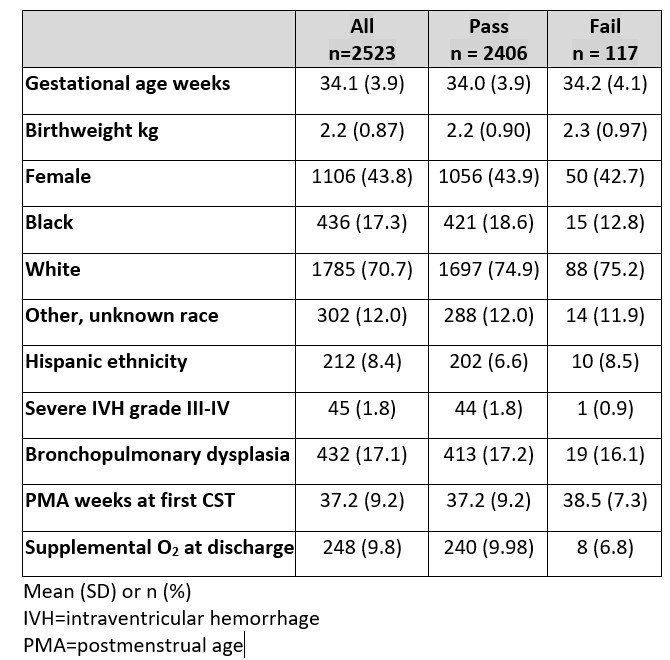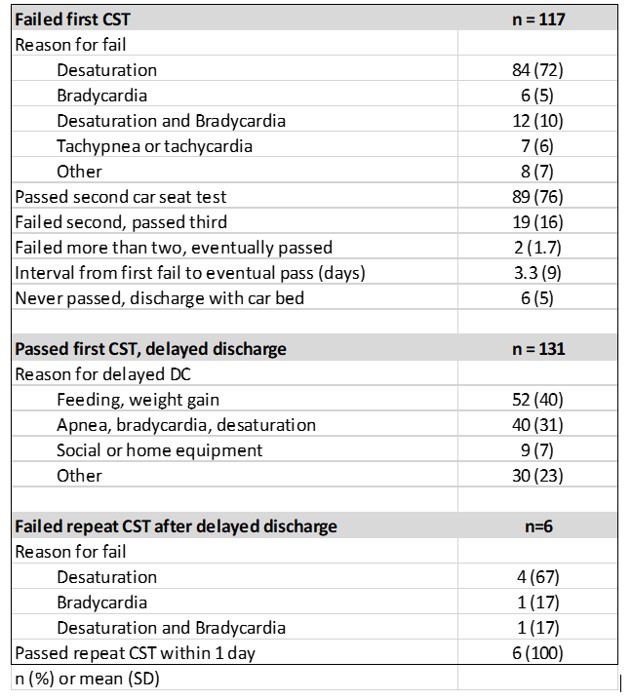Neonatal General 3: NICU Practices
Session: Neonatal General 3: NICU Practices
544 - Car Seat Tests in the NICU: Pass, Fail, and Opportunities for Improvement
Friday, April 25, 2025
5:30pm - 7:45pm HST
Publication Number: 544.4148
Paige Howard, University of Virginia School of Medicine, Charlottesville, VA, United States; Britney K. He, University of Virginia School of Medicine, Charlottesville, VA, United States; Karen D. Fairchild, University of Virginia School of Medicine, Earlysville, VA, United States

Karen D. Fairchild, MD
Professor of Pediatrics
University of Virginia School of Medicine
Earlysville, Virginia, United States
Presenting Author(s)
Background: The AAP recommends that all infants born < 37 weeks gestation or with risk factors such as hypotonia undergo a car seat test (CST) prior to hospital discharge. Details of when and how to conduct the CST vary, and understanding characteristics and outcomes of infants that fail the CST might inform clinical practice.
Objective: Identify clinical characteristics and outcomes of NICU patients who fail the CST
Design/Methods: We conducted a retrospective review of all CSTs in a single level IV NICU from January 2018 to January 2024. During that time period, a 120 minute CST was required within 2 days of discharge, and failure was defined as clinicians determining that a change in vital signs was important, without defined thresholds. For every infant that had more than one CST, we reviewed flowsheet vital signs and documentation for all CSTs. We compared demographic and clinical data for infants who passed versus failed their first CST, using Pearson’s Chi-square or Student’s t-tests. We reviewed results of repeat CST both for those that failed the first test and for those that initially passed but required a subsequent CST due to delayed discharge.
Results: During the study period, 2861 CSTs were performed on 2523 infants (median GA 34 weeks). A total of 117 infants (5%) failed the first CST. Table 1 shows that there were no significant differences in demographics or clinical variables between those that passed versus failed their first CST (all p values >0.05). Reasons for failure shown in Table 2, the major reason being oxygen desaturation (72%). Of the 117 babies who failed the first test, 89 (75%) passed the second (mean 1.8 days after the first), 21 required 3 or more tests and eventually passed, and 6 never passed and were discharged in a car bed. There were 132 infants who passed their first CST but had delayed discharge for reasons shown in Table 2. Per unit protocol, these infants had a repeat CST within 2 days of discharge and 6 did not pass that test but all passed a subsequent test within 1 day.
Conclusion(s): In this single-NICU 6-year retrospective review the rate of car seat test failure was 5% and we did not identify differences in infants that passed versus those that failed the first test. Our unit protocol was changed in 2024, eliminating the requirement that the test be performed within 2 days of discharge and shortening the duration to 90 minutes.
Table 1
 Clinical characteristics of infants based on pass/fail of first carseat test
Clinical characteristics of infants based on pass/fail of first carseat testTable 2
 Outcomes of infants that failed initial CST or passed CST but had delayed discharge
Outcomes of infants that failed initial CST or passed CST but had delayed discharge
